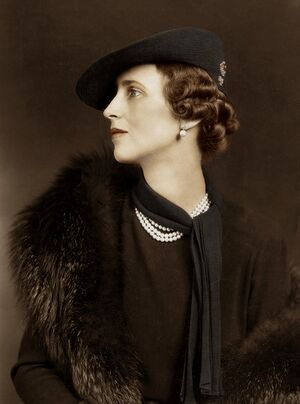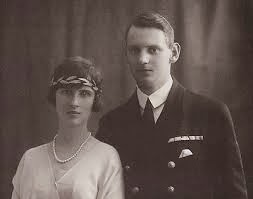Lucilia of Exponent
This article is incomplete because it is pending further input from participants, or it is a work-in-progress by one author. Please comment on this article's talk page to share your input, comments and questions. Note: To contribute to this article, you may need to seek help from the author(s) of this page. |
| Lucilia of Exponent Princess of Exponent Queen of Great Nortend | |
|---|---|
 Lucilia Exponentia, 1932 | |
| Queen of Great Nortend | |
| Reign | 1929 - 2002 |
| Full name
Lucilia Exponentia | |
| Titles and styles
Princess of Exponentia (abolished in 1997) Queen of Great Nortend Queen Dowager of Great Nortend | |
| Born | February 19, 1907 Paradisa, Empire of Exponent |
| Died | Great Nortend |
| Noble family | House of Exponentia |
| Spouse(s) | King George III of Great Nortend |
| Issue
Prince Henry Princess Julia Prince Tiberius Princess Claudia | |
| Father | Liberius XXI, Emperor of Exponent |
Queen Lucilia, also known as Lucilia of Exponent and known familiarly as Lucy in the Nortish royal family was Queen of Great Nortend as the wife of King George III of Great Nortend. She was the youngest daughter of Liberius XXI of the Empire of Exponent. During her reign, she became well known within Great Nortend for her rural activism and her staunch advocacy for Great Nortend's countryside life.
Early life
Lucilia was born on February 19, 1907 at the Imperial Palace in Paradise City, Empire of Exponent.
Marriage and children

Lucilia married Prince George of Nortend on July 23, 1929 in the large Lady Chapel of Lendert Cathedral Priory, the traditional location of weddings of the heir to the throne in Great Nortend. She lived with Prince George thereafter at Whistler's Lodge in the grounds of the Castle of Hameford, as well as in an apartment at the Palace of St. Michael'sgate. She bore three children, all with very difficult pregnancies and labour—Charles, Catherine and Susanna.
Rural activism
Shortly after marrying Prince George, Lucilia began advocating on behalf of the rural workers of Great Nortend as royal patroness of the Royal Countryside Society. Despite the passage of the Agricultural Practices Act of 1893, which forbade the refusal of livery of seisin to the heirs of life tenants in order to employ free labourers in their stead, more efficient mechanisation of farms meant that the amount of labour required on farms would reduce. Thus, yeoman farmers could avoid livery of seisin as they had no need to employ free labourers in any case. This had the real threat of mass unemployment and migration from the countryside into towns, which Great Nortend has hitherto managed to controllable levels.
With the approval of Lucilia, and it is believed, the King Edmund IX, the Royal Countryside Society launched a public scare campaign against the use of mechanical farm equipment on fields, claiming that the fumes were toxic and threatened the wholesomeness of Nortish produce. This was given heightened publicity when Lucilia, at an official luncheon hosted by the Lord Mayor of Lendert refused to eat a salad allegedly sourced from a farm which used motor tractors, claiming that she could „detect an unwholesome air” about the lettuce. This was later explained as being the „air of unemployment and countryside malaise”. A Royal Commission into the matter was announced and returned proposals to restrain certain types of mechanisation in agriculture for the sake of public health and the health of the land, as well as in order to limit the loss of farm labouring jobs.
The Second Agricultural Practices Bill was introduced by the Foide government in 1935 as one of his first acts as Lord High Treasurer. Despite strong opposition from the Droughers, it was passed by a majority of three in the Houses of Commons and of one in the House of Lords, Lord Cane finally agreeing to support the bill after days of negotiation. Royal assent was granted and the Great Seal affixed on Ladymas that year.
Lucilia continued as patroness for the Royal Countryside Society throughout her life, also taking up causes such as the promotion of heirloom and rare varieties and breeds and the preservation of common land and diversity. Several Royal Forests, largely neglected since the Great Astyrian War, were restored under Lucilia's orders to their mediaeval state as hunting forests for deer.
Later life
Final years and death
Titles and honors
Title and style
- 1955 – 1965: Her Majesty The Queen
- 1965 – 1985: Her Majesty The Queen Dowager
Lucilia's full formal title as Queen was :—
Her Majesty the Most High Most Mighty and Most Excellent Lady LUCILIA Queen of Nortend and Hambria Princess of Exponent Lady of Cardoby Countess of Hastica.
As queen dowager, her full formal title was :—
Her Majesty the Most High Most Mighty and Most Excellent Lady LUCILIA Queen Dowager of Nortend and Hambria Princess of Exponent Lady Dowager of Cardoby Countess Dowager of Hastica.
